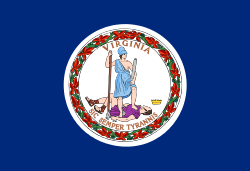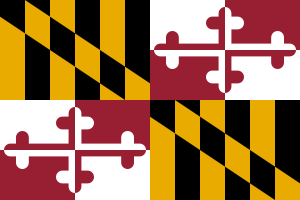American Legion Memorial Bridge (Potomac River)
| American Legion Memorial Bridge | |
|---|---|
_connecting_Montgomery_County%2C_Maryland_and_Fairfax_County%2C_Virginia_from_the_south_bank_of_the_Potomac_River.jpg) View of the west side of the bridge from the south bank | |
| Coordinates | 38°58′13″N 77°10′47″W / 38.97017°N 77.17962°WCoordinates: 38°58′13″N 77°10′47″W / 38.97017°N 77.17962°W |
| Carries |
10 lanes of |
| Crosses | Potomac River |
| Locale | Montgomery County, Maryland and Fairfax County, Virginia |
| Official name | American Legion Memorial Bridge |
| Other name(s) | Legion Bridge |
| Maintained by | Maryland State Highway Administration |
| History | |
| Opened | December 31, 1962 |
| Statistics | |
| Daily traffic | 232,000 (2010) [1] |
The American Legion Memorial Bridge, also known as the American Legion Bridge and formerly as the Cabin John Bridge, is a bridge carrying Interstate 495 (Capital Beltway) across the Potomac River between Montgomery County, Maryland and Fairfax County, Virginia in the United States. It is an American Water Landmark.
The bridge has five traffic lanes in each direction. The outermost lane in each direction is an entrance/exit-only lane for traffic to/from the Clara Barton Parkway in Maryland and the George Washington Memorial Parkway and Georgetown Pike (State Route 193) in Virginia. There are no facilities for pedestrians or cyclists, which are prohibited.
History

_just_north_of_the_American_Legion_Memorial_Bridge_in_Bethesda%2C_Montgomery_County%2C_Maryland_during_evening_rush_hour.jpg)
Opened on December 31, 1962,[2] the bridge was originally named the "Cabin John Bridge" because of its proximity to the community of Cabin John on the Maryland side of the Potomac River. The bridge opened without a ceremony due to the cold weather.[3] On May 30, 1969, the bridge was officially renamed the "American Legion Memorial Bridge" in a ceremony led by Lt. Gen. Lewis B. Hershey, director of the U.S. Selective Service System.[4] This action reduced confusion with the Union Arch Bridge, which carries the Washington Aqueduct and MacArthur Boulevard across Cabin John Creek and which some people also called "the Cabin John Bridge". The bridge was widened from its original 6-lane configuration to the current 10-lane version by 1992 via a third span filling the median between what was originally two separate spans.[5]
The American Legion Memorial Bridge is an important commuter route because of its proximity to edge cities and high tech centers in Maryland and Virginia. It is the only high volume crossing between Montgomery County, Maryland and Fairfax County, Virginia, the most populous counties in their respective states. It is also the only major crossing between Maryland and Virginia between the Point of Rocks Bridge, more than 30 miles (50 km) upstream and the Chain Bridge downstream between the Commonwealth of Virginia and the District of Columbia. The only other crossing in this stretch is the low-volume White's Ferry, which is also the last operating ferry on the Potomac. Congestion on the American Legion Bridge and commuter travel between the western Washington suburbs in both states has fueled support for a western bridge around the Loudoun County/Fairfax County line in Virginia (Virginia Route 28/Fairfax County Parkway area), or farther out as part of the Western Transportation Corridor.[6] Opponents claim that another bridge would increase development in those areas, increase traffic, and generate more pollution in the Chesapeake Bay.[7]
The bridge crosses the western terminus of the Potomac Heritage Trail and the George Washington Memorial Parkway on the Virginian side of the Potomac River. On the Maryland side, the bridge crosses over MacArthur Boulevard, the Clara Barton Parkway and the Chesapeake and Ohio Canal. Lock 13 (Seven Locks 6) of the canal is underneath the bridge.
The American Legion Memorial Bridge is one of the two locations at which the Capital Beltway crosses the Potomac River; the other is the Woodrow Wilson Memorial Bridge.
See also
-
 Bridges portal
Bridges portal -
 Virginia portal
Virginia portal -
 Maryland portal
Maryland portal - List of crossings of the Potomac River
References
- ↑ Metropolitan Washington Council of Governments. "TRANSPORTATION ACROSS THE AMERICAN LEGION BRIDGE: The 50th Anniversary and Beyond - Current and Future Traffic" (PDF). Retrieved 2016-10-13.
- ↑ "Cabin John Bridge Opens to Light Traffic". The Washington Post. January 1, 1963. p. B2.
- ↑ "Cabin John Span Opens Monday: Cabin John Bridge To Open". The Washington Post. December 29, 1962. p. A1.
- ↑ "Cabin John Bridge Given a New Name". City Life. The Washington Post-Times Herald. Washington, D.C. May 31, 1969.
- ↑ Northern Virginia Transportation Alliance. "American Legion Bridge". Retrieved 2016-10-12.
- ↑ Ginsberg, Steven (May 11, 2004). "Traffic Study Renews 'Techway' Debate: Most Md. Drivers Who Cross Legion Bridge Turn West, Researchers Find". The Washington Post. Washington, D.C.: The Washington Post Company. Archived from the original on September 18, 2012. Retrieved September 18, 2012.
- ↑ Chesapeake Bay Foundation (August 2001). "A Northern Potomac River Crossing: Will It Address Regional Congestion?" (PDF). Annapolis, Maryland: Chesapeake Bay Foundation. Archived from the original (PDF) on October 27, 2002. Retrieved October 27, 2002.
Further reading
- Laris, Michael (August 5, 2007). "Inspections Note Significant Flaws, But Officials Call Area Bridges Safe". The Washington Post. Washington, D.C.: The Washington Post Company. Archived from the original on May 2, 2014. Retrieved May 2, 2014.
- Tuss, Adam (January 30, 2012). "New Potomac river crossing coming?". WTOP Answer Desk. WTOP. Archived from the original on May 2, 2014. Retrieved May 2, 2014.
- Tuss, Adam (February 1, 2012). "Leaders talk seriously about new Potomac bridge". Local News. WTOP. Archived from the original on February 14, 2013. Retrieved February 14, 2013.
- Kunkle, Fredrick (March 30, 2012). "Maryland, Virginia revisit talks on possible new Potomac River crossing, officials say". The Washington Post. Washington, D.C.: The Washington Post Company. Archived from the original on May 2, 2014. Retrieved May 2, 2014.
- Samuel, Peter (December 4, 2012). "Virginia DOT study of Potomac River crossings, Maryland not interested for now". Toll Road News. Pine Street Publications, LLC. Archived from the original on May 2, 2014. Retrieved May 2, 2014.
- Di Caro, Martin (February 10, 2014). "McAuliffe Administration Reopens Possibility Of New Potomac River Bridge". WAMU. American University Bridge. Archived from the original on May 2, 2014. Retrieved May 2, 2014.
External links
- American Legion Memorial Bridge at Structurae
- Map and satellite image from Eyeball series